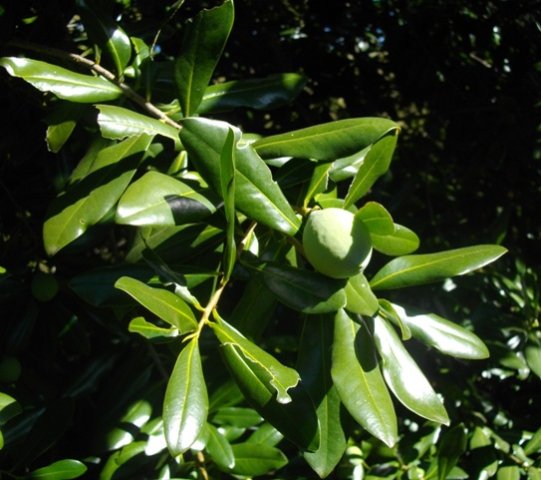Warburgia salutaris

Author: Ivan Lätti
Photographer: Ivan Lätti
Warburgia salutaris, the pepper-bark tree, rarely reaches a height of 20 m (SA Tree List No. 488). Great height is only achieved in favourable circumstances, such as in the moist, wooded and rocky ravines where the forest citizens compete hard for sunlight. The typical height of this slender tree is only 5 m to 10 m.
The bark of the pepper-bark tree is brown, dark brown and rough. The young twigs are long and lax with lenticels. Much of the tree is aromatic.
The leaves are simple, spirally arranged and crowded at branch ends. Leaf shape is lanceolate to elliptic with entire margins and a petiole of up to 5 mm long. Leaf tips and bases taper. The leaf colour is bluish when young, becoming dark green and glossy on top later, paler below. The midrib is often slightly off-centre, the veining inconspicuous and there are many gland dots. Leaves often curve downwards at the margins, upwards along the pale midribs. The leaves also exude a peppery smell when crushed.
The flowers are small, growing solitary. Flower colour is white or greenish white. The corolla consists of ten rounded petals in 2 concentric whorls.
The oval to globose pale green berry that follows can be seen in this photo. The skin is leathery, covered in scattered glands. The fruit becomes purple when ripe.
The tree grows in the northeast of South Africa, the north of KwaZulu-Natal, Mpumalanga and Limpopo and beyond the border as far as Malawi and Zambia.
The habitat is evergreen forest, bushveld and wooded ravines. The species is considered to be endangered in its habitat early in the twenty first century, due to excessive harvesting, particularly the stripping of bark.
The inner bark of Warburgia salutaris tastes bitter and peppery, giving cause to the common name. How did this become well-known? Various bits of this tree have been ingested by people in some form as concocted medicines since times immemorial. The results have continually favoured furtherance of such practices. This traditional panacea is still significant in modern medicine, but lay experimentation must always be discouraged. The medicinal status of the tree is reflected in the specific adjective, salutaris (health giving).
Plant this tree! This has been common advice to gardeners for countering the trees destruction caused by excessive muti harvesting. A cultivation project exists in KwaZulu-Natal for the species to ensure its survival (Coates Palgrave, 2002; Schmidt, et al, 2002; Van Wyk and Gericke, 2000; Venter, et al, 1996; http://redlist.sanbi.org).

